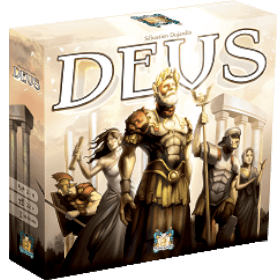데우스
 여러분은 고대 문명의 지도자로서 미지의 땅을 탐사해 제국을 확장합니다. 천연 자원을 얻고 무역로를 확보하려 새 도시를 세우고 건물을 짓게 됩니다. 야만인 부락 정복을 목표로 출정하거나 과학 지식을 늘려보세요.
여러분은 고대 문명의 지도자로서 미지의 땅을 탐사해 제국을 확장합니다. 천연 자원을 얻고 무역로를 확보하려 새 도시를 세우고 건물을 짓게 됩니다. 야만인 부락 정복을 목표로 출정하거나 과학 지식을 늘려보세요.
신과의 관계 유지도 잊으면 안 됩니다!
제물을 바치고 으리으리한 신전을 지어 신들을 기리세요.
플레이어 수: 2 - 4
게임 시간: 33 mn
복잡성: 3 / 5
데우스 및 다른 게임 1194개를 온라인으로 즐겨보세요.
다운로드가 필요없으며, 웹 브라우저에서 바로 플레이할 수 있습니다.
친구들과 그리고 전세계의 수많은 게이머들과.
무료.

데우스 및 다른 게임 1194개를 온라인으로 즐겨보세요.
다운로드가 필요없으며, 웹 브라우저에서 바로 플레이할 수 있습니다.
친구들과 그리고 전세계의 수많은 게이머들과.
무료.

규칙 요약
Basic Flow
On each turn you have 2 options:
Build a building
Choose a card from your hand, pay for it (if able) and place on an available map location. Move the card to the top of the relevant column of your tableau, and resolve all cards in that column, in order from bottom to top.
Maritime buildings can only be built on water (blue spaces on the tiles). Non-maritime buildings cannot be built on water.
Make an offering to the gods
Discard one or more cards from your hand, choosing one to discard on top. Receive a benefit of type depending on the colour of that top card, and of size corresponding to the number of cards discarded.
More detail
TYPES OF CARDS There are 6 types of card:
- Maritime (blue). Connected with trade, effects include buying resources for gold, and selling resources for gold or VP
- Production (green). Produce resources, always of the type associated with the terrain type the corresponding building is on (forests produce wood, swamps produce clay, mountains produce stone, and farms produce wheat).
- Scientific (yellow). Have a variety of effects, including drawing cards and gaining new buildings (thus reducing the need for making offerings). Some yellow cards allow activation of cards of other colours, or score for the number of cards of another colour.
- Civil (brown). Give either gold or victory points based on the arrangement and/or locations of your buildings on the map.
- Military (red). The military units these cards let you build are used for attacking barbarian villages. Some military cards can also move military units around the map. Others steal from other players.
- Temples (purple). Have no immediate effect when built, but are worth victory points at the end of the game (up to a maximum of 12) depending on how well you meet the conditions stated on the card.
BUILDING
When building, you must have a building of the appropriate type available in your supply (ie on your player board below the column).
You may always freely substitute 4 gold for each of the 4 main resources (wood, stone, clay, wheat) when paying for a building.
Maritime buildings ("ships") can only be built on sea locations, and are the only types of building which can be built there - all others must be built on land. (You may move a military unit over or onto a sea location where you have a ship, but you cannot build one there directly.)
Your first build must be at the edge of the map, and (if possible) at least 3 spaces away from any opposing building. Subsequent builds can only be on or adjacent to locations where you already have a building - with one exception: you can always build on any empty location on the edge of the map, but must pay 3 VP if it does not meet the adjacency rule.
Two different players can never occupy the same location.
You cannot have more than one building of each type on any one location. (Thus the maximum number of buildings you can have on any one location is 5 - one each of production, scientific, civil, military and temple.)
Temples cannot be built on empty locations, but only in (non-sea) locations that you already occupy. You may not build a second temple until you have built at least one of each of the other building types, or a third temple until you have built at least 2 of each of the other types, and so on. (You can tell this at a glance from your player board - the Temple column is offset a little below the rest so you can only build a temple if the rest of its "row" is fully occupied with cards.)
Temples also cannot be "abandoned" - so if you have a military unit on a location with a temple and no other buildings, you may not move that military unit.
OFFERINGS
When making an offering, you always draw up to 5 cards and gain 1 building from the stock of the appropriate type. (Assuming any are available - you have 5 of each type.) You also get another benefit depending on the God that you make the offering to - which is determined by the colour/type of the card you discarded on top. God benefits are:
- Neptune (blue/maritime): gain 2 gold per card discarded
- Ceres (green/production): gain 1 resource of your choice per card discarded
- Minerva (yellow/scientific): draw 1 additional card for each card discarded. (Eg if you discard 3 cards, you draw up to a minimum of 8 cards rather than 5. This takes place AFTER drawing to 5, so you always draw at least as many cards as the number discarded, even if you still have a large hand after discarding.)
- Vesta (brown/civil): gain 1 VP token if you discarded 1 card, or 2 VP tokens if you discarded 2 or more. (There is no further VP benefit to discarding 3 or more.)
- Mars (red/military): gain a total of 1 building per card discarded, which you can freely choose. You do not have to choose any military buildings.
- Jupiter (purple/temple): choose any of the other 5 Gods to benefit from (still according to the number of cards discarded)
You may never hold more than 10 cards in your hand - if you would draw more, you simply stop drawing.
If you build the last card in your hand, you automatically draw back up to 5. (But do not gain any of the other benefits associated with making an offering.)
The resource stock is strictly limited - to 5 per player of each resource. If you would gain more, you simply do not gain the excess. Coins and VP tokens are unlimited.
If the deck runs out, the discard pile is reshuffled to form a new deck.
Barbarian Villages
Each barbarian village location holds a number of VP (starting at 1VP for each adjacent location). They can never be built on, even when emptied of VP. Any card effects which refer to barbarian villages (notably Ballista) do not count villages which have no VP left.
A village is attacked as soon as the following 2 conditions are both met:
- each surrounding location is occupied by at least 1 building
- there is at least one military building on the surrounding locations
As soon as this happens - before resolving any further cards or even (in the case of War Elephants) before moving any more armies - the village attack is resolved, with the VP going to the player who has most military buildings surrounding the village. If tied, the VP go to the tied player with most buildings in total on the surrounding locations. If still tied, the players share the VP, with any excess removed from the game.
End of the game
The game end is triggered when one of the following 2 conditions is met:
- the last barbarian village is emptied of VP (either via a normal attack or via the Siege Tower card)
- the Temple stock is exhausted (the number of players available in the stock at the start of the game is 4 in a 2-player game, 6 in a 3-player game and 7 in a 4-player game)
When this happens, the current round is finished, then each player gets 1 more turn.
Temple cards can still be built after the stock is exhausted, and their VP will count - but no temple piece will be placed on the map. The temple card which scores 4 VP per temple played counts temple cards, not temple pieces on the map. Other temples which count buildings only count those physically on the map.
Scoring
VP are scored for the following:
- VP tokens earned during the game (which are kept hidden until the end of the game). These can be scored from defeating barbarian villages, or from a variety of card effects (mostly maritime, scientific and civil cards).
- each temple scores VP for the player who played it according to its text (up to a maximum of 12 for each temple card)
- finally, for each of the 4 basic resources plus gold, the player with the most of that resource remaining gets 2 VP. (If tied, all tied players get the 2VP - but no-one gets anything for that resource if no player has any.)
The player with the most VP wins. There is no tiebreak.

